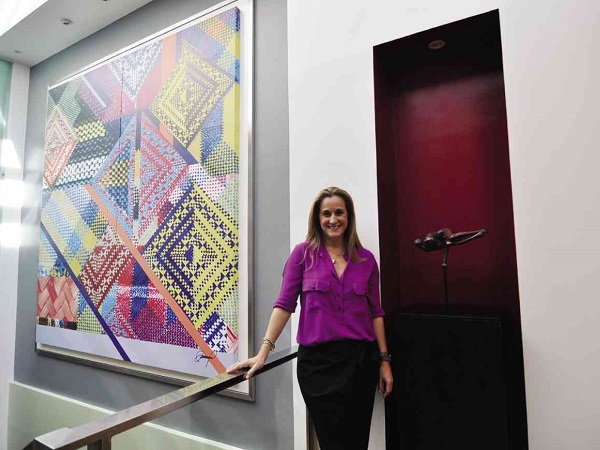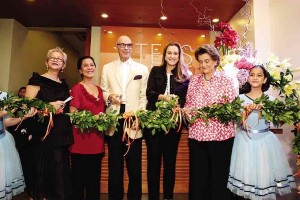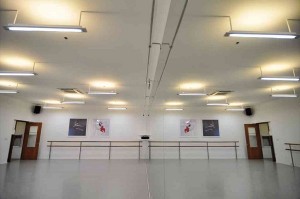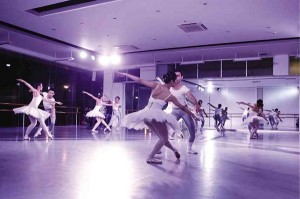
A few blocks away from where mini-skirted, dusky, long-haired ladies in platformed stilettoes stroll hand-in-hand with foreign men in Birkenstocks and cargo shorts, and a corner away from a bar that features midget boxing, karaoke joints offering foot massages on the side, and cafés that serve Lonely Planet meals and drinks, has risen a glass-and-concrete building with a lofty but realistic purpose of training young would-be dancers in ballet, an art form that is perceived by a majority to be elitist.

At the helm of the enterprise is Sofia Zobel-Elizalde, a member of that clan whose surname is synonymous with avenues and malls. Yet, the building she has erected is off her family’s vast property. “I’m being realistic,” she says. “Ballet studios don’t make much money. It needs a big space. So you choose a location that answers the need and is financially manageable.”
Twenty years after she opened Steps Dance Studio in a rented space, first on Estrella Street in Makati, then moving to Yakal Street, and then to a more “posh” location at Karravin Plaza alongside the gourmet deli Terry’s, Elizalde proudly announces that, finally, this building is owned, it’s “home,” and this being so, she has poured in all the features that she ever dreamed of in a dance studio.
These are things she had observed along the way from her dance student days at Elmhurst School of Dance in England, her year at the New York City Ballet School, and her stint as a company member of the Cultural Center of the Philippines (CCP) Dance Company (now Ballet Philippines), where she remembers taking naps on the rehearsal room floor.

At every turn in the new studio, there is a story to tell.
Crucial
The dance floor is perhaps the most crucial feature in a ballet studio, being literally the ground on which to dance. Ideally, a ballet floor needs to have a kind of spring that gives the dancer a softer landing, helping prevent injuries, specifically to the knees. “For years, I thought sprung floors were expensive and unaffordable. But I bit the bullet and ordered the floors at Harlequin,” she says.
“Sprung floors,” of which Harlequin is the best known, are slightly elevated; the joists are made of a special wood and, to cushion dancers’ landings, there are strategically placed rubber pieces that soften the impact of, say, a grand jeté.

“They weren’t that expensive, ” she explains, seeing this as an investment and protection for her 300 students. “And they are built to last a long time, so you don’t have to change floors often,” she adds.
Steps houses four studios, which, aside from the usual bars and floor-to-ceiling Belgian mirrors, contain pianos, two of which are baby grands. “The piano in a studio is a ballet tradition,” she points out, bemoaning the fact that these have been replaced by state-of-the art disc players (also available at the studios); at the same time she understands the cost of maintaining the instrument and hiring a piano player for classes. “I want it (the setup) as faithful as possible to the real thing.”
A rather curious feature is a sink with a faucet located on the floor outside the studios. When asked about this, Elizalde laughs and explains its function is to soften a pair of new pointe shoes a dancer has to wear for the first time by wetting the toe to conform to the shape of the dancer’s foot.

To the initiated, the “molding” of a new pointe shoe is a sacred ritual that not only entails the sewing of the ribbon by the dancer herself to conform to the fit, but also sometimes hammering the pointe and bending the shoe to make it a very personal extension of the dancer’s foot. The proximity of the water feature to the studio simply makes it more convenient for the dancer. This, Elizalde had observed at the studios of the New York City Ballet.
Obsessed
To make this otherwise excruciating instrument even more personalized, Elizalde has made available at the dance shop a variety of pointe shoe brands for every shape and size of dancers’ feet, plus a fitting room for the shoes with linoleum flooring to approximate the feel of a dance floor. The dance shop itself is conceptualized as a dressing room of a young girl obsessed with ballet: from dance wear, posters and dance videos, to Elizalde’s grandmother’s crystal chandelier that dominates and holds together the look of the shop.
At strategic spaces are blown-up pictures of students who have passed through Steps and have made a name for themselves in the dance world: Namcya (National Music Competition for Young Artists) gold medalist Monica Gana; silver medalist Rudolf Capangcol; Marcelino Libao, the present pride of Elizalde, who won at the Prix de Lausanne and now dances with the Hamburg Ballet.
Artworks accent the walls: a photo art of her father, Don Jaime Zobel; and sculptures of dance figures by Jordan Mendoza poised in front of a Venetian red wall. An empty wall at the foyer awaits the work of one of Elizalde’s favorite collaborators, scenographer Gino Gonzales. There is a room that houses Gonzales’ costumes for the school’s productions.
Teachers have their own lounge, equipped with their own lockers, where they can prepare for class or just linger over cups of tea or coffee, away from the enthusiastically curious would-be stage mothers and yayas who are relegated to a rectangular peep space located by every studio. They can otherwise hang out in their own lounge as they wait for their wards. Adds Elizalde with a giggle, “And I also have my own office, finally!”
The biggest hall, the BMZ room, named after Elizalde’s mother, Beatriz Miranda Zobel, is a glassed-in, multipurpose space. Recalling a similar studio in New York, it is here where examinations for the Royal Academy of Dance are held. Outfitted with battens to hang lights on, running all over the ceiling, the neutral space, which approximates the CCP Little Theater stage, can also serve as a performance area which Elizalde intends to rent out at a reasonable cost for small theater performances or works-in-progress.
Arts hub
With a performer’s heart at best, Elizalde hopes to see the environs as an arts hub. Already, next door at the SJG building is the studio of Fundacion Centro Flamenco, among the pioneer flamenco studios in Manila.
“Steps is a dance school, and it should produce dancers,” Elizalde says, turning serious. “Having this school now has brought me full circle, from a young dance student to a teacher. Seeing dancers inspires me. Some dancers, when they stop dancing, throw in the towel and become a secretary or a flight stewardess,” she says, smirking at her own joke. “But I always feel the need to move—I’m taking dance classes again.”
She pauses, turns contemplative, and then breaks into a wide grin. “It’s very simple—I really enjoy it!” Then she goes on to explain how teacher and choreographer Marion Ignacio had choreographed “Vivaldi” for Steps’ opening day with the excitement of both a dance student and a mentor as well.
On opening day, Dec. 4, Elizalde’s whole family, led by her parents, Don Jaime and Doña Beatriz Zobel, her friends, faithful supporters and families of students came to experience the joy and excitement Elizalde clearly contaminated everyone with, personally greeting each guest.
Instead of the usual tour of the space, Elizalde prepared a short music and dance presentation in each studio, featuring every student level per studio: baby ballet, young scholars, the advanced class and the jazz class.
Guests lined up in groups and took turns joining a carefully planned studio performance tour, viewing dances prepared by the dance teachers and choreographers. Elizalde’s generous crediting of her colleagues, collaborators and students alike was most obvious. Former colleagues from Ballet Philippines like Denisa Reyes, Nonoy Froilan, Cecile Sicangco, Perry Sevidal, Victor Ursabia, Brando Mirada, among others, were in attendance to give Elizalde (who was among the younger dancers in their time) their best wishes, also offering her their support and collaboration whenever she needed them, as Elizalde extended an open invitation for them to come and use the studio.
Looking from whence she came, and looking forward to more years of her dedication to dance, Elizalde would see each guest off with a cheery send-off question: “Did you enjoy yourself?” Because she clearly did.












































